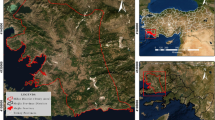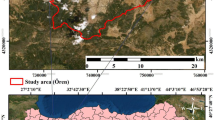Abstract
Forest fire is a major cause of changes in forest structure and function. Among various floristic regions, the northeast region of India suffers maximum from the fires due to age-old practice of shifting cultivation and spread of fires from jhum fields. For proper mitigation and management, an early warning of forest fires through risk modeling is required. The study results demonstrate the potential use of remote sensing and Geographic Information System (GIS) in identifying forest fire prone areas in Manipur, southeastern part of Northeast India. Land use land cover (LULC), vegetation type, Digital elevation model (DEM), slope, aspect and proximity to roads and settlements, factors that influence the behavior of fire, were used to model the forest fire risk zones. Each class of the layers was given weight according to their fire inducing capability and their sensitivity to fire. Weighted sum modeling and ISODATA clustering was used to classify the fire zones. To validate the results, Along Track Scanning Radiometer (ATSR), the historical fire hotspots data was used to check the occurrence points and modeled forest fire locations. The forest risk zone map has 55.63% of agreement with ATSR dataset.
Similar content being viewed by others
References
Bell FG. 1998. Environmental Geology: Principles and practice. Blackwell Science limited, Available on: www.books.google.co.in [Accessed 15 June 2010].
Chuvieco E, Aguado I, Yebra M, Nieto H, Salas J, Martín MP, Vilar L, Martínez J, Martín S, Ibarra P, Riva J, Baeza J, Rodríguez F, Molina JR, Herrera MA, Zamora R. 2010. Development of a framework for fire risk assessment using remote sensing and geographic information system technologies. Ecological Modelling, 221(1): 46–58.
Environment Information Centre, Manipur, Environment & Ecology Wing, Govt Of Manipur, Available on: http://www.manenvis.nic.in/ [Accessed 20 June 2010].
Giriraj A, Babar S, Jentsch A, Sudhakar S, Murthy, MSR. 2010. Tracking Fires in India Using Advanced Along Track Scanning Radiometer (A)ATSR Data. Remote Sensing, 2: 591–610.
Hussin YA, Matakala M, Zagdaa N. 2008. The applications of remote sensing and GIS in modeling forest fire hazard in Mongolia. In: The International Archives of the Photogrammetry, Remote Sensing and Spatial Information Sciences, Vol. XXXVII. (Part B8. Beijing): pp.289–294.
Jaiswal RK, Mukherjee S, Kumaran DR, Saxena R. 2002. Forest fire risk zone mapping from satellite imagery and GIS. International Journal of Applied Earth Observation and Geoinformation, 4(1): 1–10.
Keane RE, Drury SA, Karau EC, Hessburg PF, Reynolds KM. 2010. A Method for Mapping fire hazard and risk across multiple scales and its application in fire management. Ecological Modelling, 221: 2–18.
Kunwar P, Kachhwaha TS. 2003. Spatial Distribution of Area Affected by Forest Fire in Uttaranchal using Remote Sensing and GIS Techniques. Journal of the Indian Society of Remote Sensing, 31(3): 145–148.
Lozano JF, Seoane S, Kelly M, Luis E. 2008. A multi-scale approach for modeling fire occurrence probability using satellite data and classification trees: A case study in a mountainous Mediterranean region. Remote Sensing of Environment, 112(3): 708–719.
Maeda EE, Formaggio AR, Shimabukuro YE, Arcoverde GFB, Hansen MC. 2009. Predicting forest fire in the Brazilian Amazon using MODIS imagery and artificial neural networks. International Journal of Applied Earth Observation and Geoinformation, 11(4): 265–272.
Mbow C, Goita K, Bénié GB. 2004. Spectral indices and fire behavior simulation for fire risk assessment in savanna ecosystems. Remote Sensing of Environment, 91(1): 1–13.
Official website of Manipur, City Development Plan: Imphal, Available on: http://manipur.nic.in [Aceesed 21 June 2010]
Paul M, Paul PP. 2009. Beneficial effects of shifting cultivation (jhum). Current Science, 96(1): 10.
Planning Department, Government of Manipur, Available on: www.planningmanipur.gov.in [Accessed 20 June 2010].
Ranjan R, Upadhyay VP. 1999. Ecological problems due to shifting cultivation. Current Science, 77(10): 10.
Rawat GS. 2003. Fire risk assessment for forest fire control management in Chilla forest range of Rajaji National Park Uttranchal, India. M.Sc Thesis, Indian Institute of Remote Sensing and International Institute for GeoInformation Science and Earth Observation, ITC.
Roy PS. 2003. Forest fire and degradation assessment using satellite remote sensing and geographic information system. In: M.V.K. Sivakumar, P.S. Roy, K. Harmsen, S.K. Saha (eds), Satellite Remote Sensing and GIS Applications in Agricultural Meteorology. Geneva 2, Switzerland: World Meteorological Organisation, pp. 361–400.
Srivastava SK. 2006. A GeoInformation System Approach for Strengthening Conservation Measures in Protected Area with Reference to Forest Fire. M.Sc Thesis: Indian Institute Of Remote Sensing and International Institute for GeoInformation Science and Earth Observation, ITC.
Systems for Environmental Management, Public Domain Software For Wildland fire community, Fire Models Available on: www.fire.org [Accessed 1 June 2010].
Author information
Authors and Affiliations
Corresponding author
Additional information
The online version is available at http://www.springerlink.com
Rights and permissions
About this article
Cite this article
Puri, K., Areendran, G., Raj, K. et al. Forest fire risk assessment in parts of Northeast India using geospatial tools. Journal of Forestry Research 22, 641–647 (2011). https://doi.org/10.1007/s11676-011-0206-4
Received:
Accepted:
Published:
Issue Date:
DOI: https://doi.org/10.1007/s11676-011-0206-4




